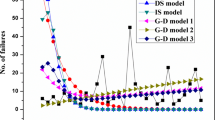Abstract
This paper demonstrates the applicability of transfer function model in the field of software reliability. Here a stepwise procedure for fitting a transfer function model has been described and then the prediction of remaining faults in software has been done using the built in model. Some real life data have been used for illustration purpose.
Similar content being viewed by others
References
Musa JD, Iannino A, Okumoto K (1987) Software reliability measurement, prediction, application. McGraw-Hill Int, UK
Xie M (1991) Software reliability modelling. World Scientific Press, UK
Pham H (2006) System software reliability. Springer, UK
Goel AL (1985) Assumptions, limitations and applicability of software reliability modelling. IEEE Trans Software Eng 11: 1411–1423
Jelinski Z, Moranda PB (1972) Software reliability research. In: Freiberger W (ed) Statistical computer performance evaluation. Academic Press, New York, pp 465–484
Shooman ML (1972) Probabilistic models for software reliability prediction. In: Freiberger W (ed) Statistical computer performance evaluation. Academic Press, New York, pp 485–502
Schick GJ, Wolverton RW (1978) An analysis of competing software reliability model. IEEE Trans Software Eng SE-4: 104–120
Musa JD (1975) A theory of software reliability and its application. IEEE Trans Software Eng SE-1: 312–327
Littlewood B, Verrall JL (1973) A Bayesian reliability growth model for computer software. Appl Stat 22: 332–346
Xie M (1987) A shock model for software reliability. Microelectron Reliab 27: 717–724
Goel AL, Okumoto K (1979) A time-dependent error detection rate model for software reliability and other performance measure. IEEE Trans Rel R-28: 206–211
Chatterjee S, Misra RB, Alam SS (1997) Joint effect of test effort and learning factor on software reliability and optimal release policy. Int J Syst Sci 28(4): 391–396
Yamada S, Ohba M, Osaki S (1984) S-shaped software reliability growth models and their applications. IEEE Trans Rel R-33: 289–292
Pham L, Pham H (2001) A Bayesian predictive software reliability models with pseudo-failures. IEEE Trans Syst Man Cybern A Syst Hum 31(3): 233–238
Pham L, Pham H (2000) Software reliability models with time dependent hazard rate based on Bayesian approach. IEEE Trans Syst Man Cybern A Syst Hum 30(1): 25–35
Fakhre- Zakeri I, Slud E (1995) Mixture models for reliability of software with imperfect debugging: identifiably of parameters. IEEE Trans Rel 44: 104–113
Zeephongsekul P, Xia G, Kumar S (1994) Software-reliability growth model: primary failures generate secondary-faults under imperfect debugging. IEEE Trans Rel 43: 408–413
Xia G, Zeephongsekul P, Kumar S (1993) Optimal software release policy with a learning factor for imperfect debugging. Microelectron Rel 33: 81–86
Pham H (1996) A software cost model with imperfect debugging random life cycle and penalty cost. Int J Syst Sci 27: 455–463
Chatterjee S, Misra RB, Alam SS (1998) A generalized shock model for software reliability. Computer Electr Eng Int J 24: 363–368
Gokhale SS, Lyu MR, Trivedi KS (2006) Incorporating fault debugging activities into software reliability models: a simulation approach. IEEE Trans Rel 55(2): 281–292
Dai YS, Xie M, Poh KL (2005) Modelling and analysis of correlated software failures of multiple types. IEEE Trans Rel 54(1): 100–106
Xie M, Dai YS, Poh KL, Lai CD (2004) Distributed system availability in the case of imperfect debugging process. Int J Syst Ind Eng Theory Appl Pract 11(4): 396–405
Chatterjee S, Misra RB, Alam SS (2004) N-version programming with imperfect debugging. Comput Electr Eng 30(6): 453–463
Park DH, Lee CH (2003) Markovian imperfect software debugging model and its performance measures. Stoch Anal Appl 21(4): 849–864
Misra PN (1983) Software reliability analysis. IBM Syst J 22: 262–272
Yamada S, Osaki S (1985) Cost-reliability optimal release policies for software systems. IEEE Trans Rel 31: 422–424
Bhaskar T, Kumar UD (2006) A cost model for N-version programming with imperfect debugging. J Oper Res Soc 57(8): 986–994
Zhang X, Teng X, Pham H (2003) Considering fault removal efficiency in software reliability assessment. IEEE Trans Syst Man Cybern A Syst Hum 33(1): 114–120
Zhang X, Pham H (2000) Comparison of nonhomogeneous poisson process software reliability models and its applications. Int J Syst Sci 31(9): 1115–1123
Pham H, Normann L, Zhang X (1999) A general imperfect software debugging model with S-shaped fault detection rate. IEEE Trans Rel 48(2): 169–175
Hwang S, Pham H (2009) Quasi-Renewal Time-Delay Fault Removal Consideration in Software Reliability Modelling. IEEE Trans Syst Man Cybern A Syst Hum 39(1): 200–209
Singpurwalla ND, Soyer R (1985) Assessing (Software) reliability growth using a random co-efficient autoregressive process and its ramifications. IEEE Trans Software Eng SE-11: 1456–1464
Chatterjee S, Misra RB, Alam SS (1997) Prediction of software reliability using an auto regressive process. Int J Syst Sci 28: 205–211
Walls LA, Bendell A (1987) Time series methods in reliability. Reliab Eng Syst Saf 18: 239–265
Anselmo V, Ubertini L (1979) Transfer function-noise model applied to flow forecasting. Hydrol Sci 24: 353–359
Nason GP, Sapatinas T (2002) Wavelet packet transfer function modeling of nonstationary time series. Stat Comput 12(1): 45–56
Halas M, Kotta U (2007) Transfer Function of discrete-time Nonlinear Controls. Proc Estonian Acad Phys Math 56(4): 322–335
Singpurwalla ND (1980) Analyzing availability using transfer function models and cross spectral analysis. Nav Res Logist Quart 27: 1–16
Box GEP, Jenkins GM (1976) Time series analysis, forecasting, and control. Holden-Day, San Francisco
Lyu MR (1996) Handbook of software reliability engineering. IEEE Computer Society Press, McGraw Hill, New York
Akaike H (1974) A new look at the statistical model identification. IEEE Trans Automat Control 19: 716–723
Author information
Authors and Affiliations
Corresponding author
Rights and permissions
About this article
Cite this article
Chatterjee, S., Nigam, S., Singh, J.B. et al. Transfer function modelling in software reliability. Computing 92, 33–48 (2011). https://doi.org/10.1007/s00607-010-0128-6
Received:
Accepted:
Published:
Issue Date:
DOI: https://doi.org/10.1007/s00607-010-0128-6



